Photo


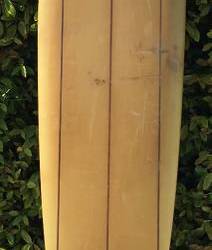



Maybe it’s the 90s hip hop fan in me, but there are few things I enjoy more than a great collaboration.
As far as vintage surfboards go, the Donald Takayama Model for Bing Surfboards has to be up there.
The board pictured above is an example of a Donald Takayama Model, created for Bing Surfboards between 1965 and 1967. It’s currently listed for sale on Craigslist in Orange County, and you can find the board here. The asking price is $1K. This may seem a little steep, but for reference, another Bing Takayama (albeit in perfect condition) recently sold for $5K at auction.
I’m able to notice a few key differences between the board at the top of the post, and then a few other Bing Takayama boards I found online. For the first comparison, see below for pictures of the Bing Takayama that was sold at auction.



Photos via LiveAuctioneers.com
The second example I was able to find was on usedsurf.jp, which always has great vintage boards for sale (albeit at steep prices, no doubt because the shop is located in Japan). I’ve reproduced those pictures below as well:




Photos via usedsurf.jp
Now, let’s compare the three boards: the Craigslist board at the top of the post, the auction board, and then the usedsurf.jp board. First, all three of the boards share the same basic outline -- a slightly pulled in nose, a triple stringer, and a squash tail in the back. However, the auction and usedsurf.jp boards also have two critical differences: they have large D-fins, as opposed to the Craigslist board’s more raked design; and second, you’ll notice the logos are slightly different. The Craigslist board’s logo has an evenly applied bold outline around the eye-shaped Bing logo; the auction and usedsurf.jp boards have an outline that gets thicker around the right side of the eye.
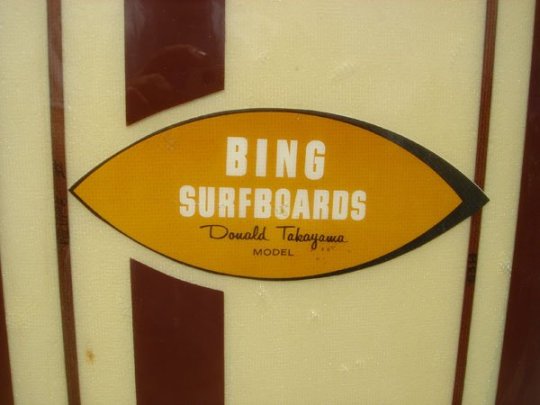
Close up of the auction board. Bolding is only on the right side of the eye logo.
Here’s my guess: the D-Fin boards (in this case, the usedsurf.jp and auction boards) were produced at a different date than the non-D-Fin boards (see one at the top of the page). The Craigslist board at the top (non-D-Fin) is dated as 1965. Usedsurf.jp dates its D-fin board to 1967. However: the auction board, also a D-Fin, is dated to 1965. Since the Takayama model was only made between 1965 and 1967, I think one of these dates must be wrong. In other words, I believe at some point Bing must have switched from the non-D-Fin to the D-Fin, or vice versa.
Consider, now, the tiebreaker. Here are two more boards I was able to find online, both of which are dated 1965 and closely resemble the Craigslist board at the top of the page. First, we have a board once listed on eBay (aka the eBay board). I can’t get a close look at the fin, but it looks like the rake fin design (not the D-Fin). Note the logo design and placement. First, it’s the logo that has bolding on right and left. Second, the logo is on the right side of the deck, fairly close to the nose.

Second is a board that was listed for sale on Cannon Beach Artz. It’s also dated to 1965. It has the same logo and placement as the Craigslist board and the eBay board, not to mention the red tail block visible on the Craigslist board.

Photo via Cannon Beach Artz
Conclusion? I believe that the earlier run of Bing Takayama boards can be identified by three things: 1) The logo with the bolding on both sides of the “eye”; 2) Placement of the logo (right side of the deck, close to the nose); and 3) A more raked fin design (versus the D-Fin). There are multiple sources that date these boards to 1965. I believe the later model -- produced in 1967, but possibly earlier -- has the D-Fin, the logo with the bolding only on the right side, and then logo placement further down the board.
If anyone has more info, I’d love to hear it. Otherwise, the Craigslist board is still for sale, and you can find it here.
0 notes
Text
Shred Sledz Presents: Weekend Grab Bag (March 5)
Greetings, Shredderz! Hope your weekend has been chock full of shapely waves and light offshore winds. Here are some finds I came across recently.
Ole Noserider on Craigslist (Orange County)

I haven’t written much about Ole Surfboards before, which was the brainchild of Bob Olson. This one sports a nice D fin and I would guess it dates to sometime in the 1960s. It might be all original, too. Priced at $975.
Mint Condition all-original 1966 Hansen Master on eBay

This one is going for $12K out the gates, which might be a little ambitious. But it’s worth clicking through for the pictures. This thing is in incredible condition -- I’m talking time capsule status.
Dyno David Nuuhiwa 70s Single Fin on eBay

The airbrush on this board is pure 1970s. Nuuhiwa was the subject of an earlier Sledz post, which I naturally recommend you read if you’re interested in learning more. Otherwise, bask in the sheer outrageousness of this paint job, which toes the line between painstaking craftsmanship and looking like a Lisa Frank parody. The board is incredible condition, but it’s no longer for sale (closed at a healthy $1,258!)
0 notes
Photo


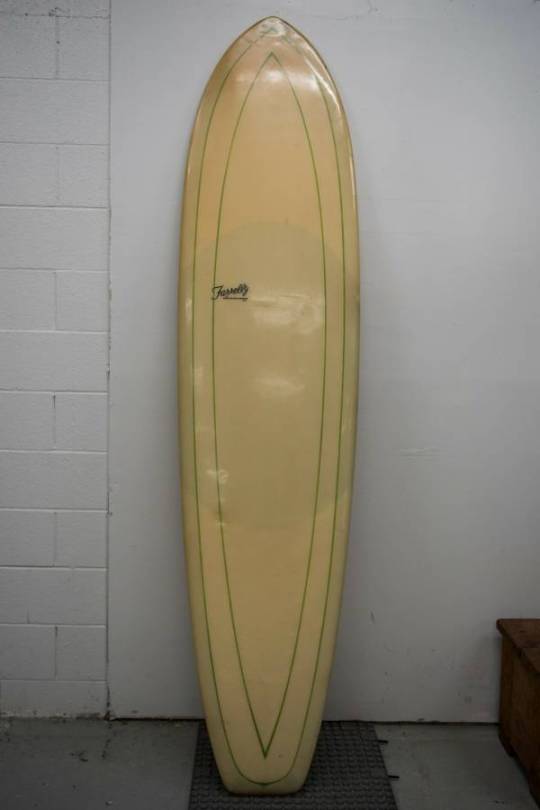
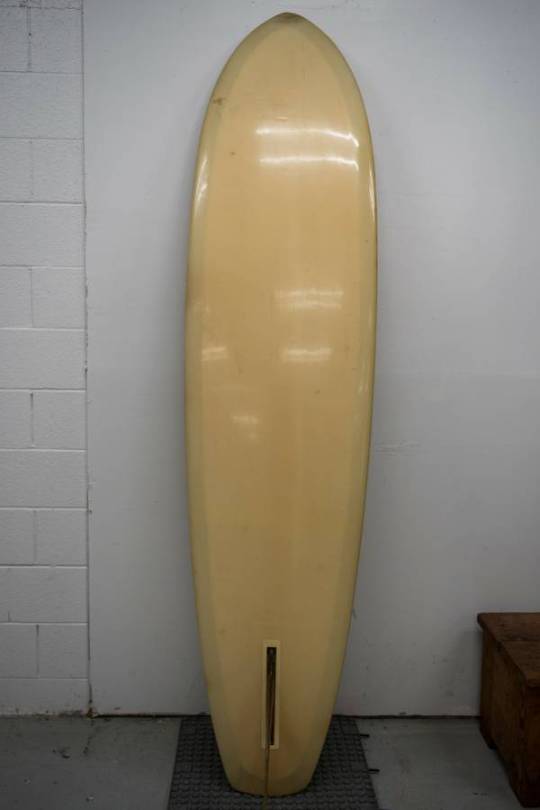
Shred Sledz is (proudly) made in California. And given HQ’s location in the Golden State (AKA my living room), it’s no surprise that the blog focuses primarily on American and Hawaiian surfboard shapers.
Today I’m excited to lend a little more Aussie influence to this modest seppo-centric blog. We’ll be exploring the history and contributions of one of Australia’s earliest surf stars: none other than the late, great Bernard “Midget” Farrelly.

Farrelly putting it on a rail.
Photo by Dick Graham, taken from his book “The Ride: 1960s and 1970s, A Photo Essay”
Farrelly won the inaugural World Surfing Championship in 1964. The event was held at Manly Beach, located in Farrelly’s hometown of Sydney. A few years later, Farrelly was an active contributor to the experimental surfboard designs of the Transition Era.
To this day there remains a heated debate over the origins of the vee bottom surfboard design. Bob McTavish, another Australian surfer and shaper, is widely credited with having invented the design in 1967. Farrelly, on the other hand, claims that he was the inventor of the vee bottom. He offers the picture below as proof. Farrelly claims the white board in the picture below was about 8�� x 22″ -- a good deal shorter than the boards being ridden by his contemporaries -- and that the picture was taken in 1967 at the Windansea vs. Australia contest in Palm Beach. Farrelly contends that McTavish did not even glimpse a vee bottom board until November of 1967, which later inspired McTavish to do his own take on the design. The Encyclopedia of Surfing, on the other hand, credits McTavish with having begun work on the vee bottom in March of 1967. McTavish says he was shaping vee bottoms at the Keyo factory in mid-1967. If you want to read more about Midget’s side of the story, I recommend going to his website. Sadly, Midget passed away last year from stomach cancer.

Photo by Dick Graham; photo via Farrelly Surfboards
While the origin of the vee bottom may be contested, I think we can all agree on one thing: transition boards -- and vee bottoms in particular -- are very, very cool.
Pictured at the top of this post is a Midget Farrelly / Gordon & Smith design that is currently up for sale on Craigslist in Monterey, California. It’s 7′10″ in length, but no other dimensions are offered up. The price is $1200 -- steep, but this is a rare surfboard, and it looks to be in good condition, other than an obvious repair on the nose.
Gordon & Smith agreed to distribute Farrelly’s boards in the United States, and this is a clear example of the partnership. In the very first picture you can see the logo reads “Farrelly by Gordon and Smith Surfboards USA”.
However, it’s unclear to me exactly what model this is. Gordon & Smith -- it’s interesting to note that the logo on the board reads “Gordon and Smith”, and doesn’t contain the customary ampersand -- produced a Midget Farrelly Stringerless model. Stoked-n-Board has the Farrelly Stringerless model as having been produced between 1967 and 1969, which means it pre-dates the creation of the vee bottom. Here’s an example of a G&S Farrelly Stringerless model, and you can see that it is longer and more of a traditional longboard shape than the board listed at the top. It’s listed at 9′6″, and Surf Research actually dates the board to 1966, a full year earlier than Stoked-n-Board. Either way, it’s clear that the board below is a different model from the one at the top of the post -- it’s longer, it has a fuller nose, and it has a different logo.

Photo via surfresearch.com.au
Here’s a close up of the G&S Farrelly Stringerless logo (from a different board).

Pic via Surfers Japan
And here’s an old print ad for the G&S Farrelly Stringerless model. Note that this is clearly more of a standard longboard / noserider design -- pre-Transition Era, I’m guessing. Note that this version of the logo has numbering. I’ve seen Stringerless logos without numbers.
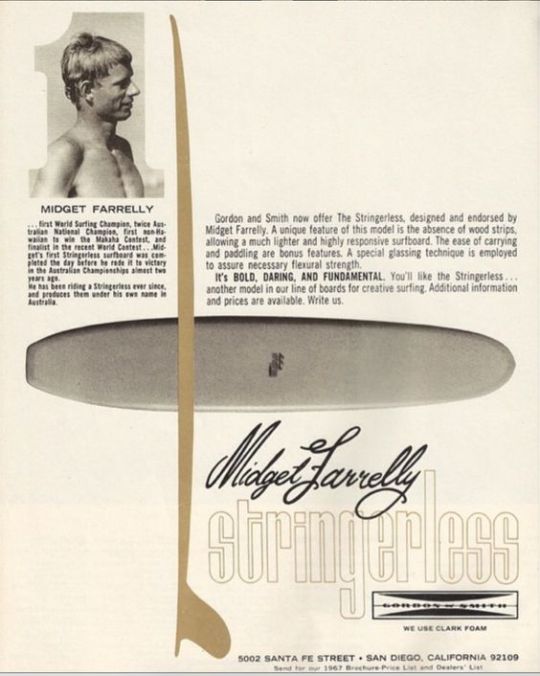
G&S has another old ad up on their website, which shows the Farrelly Stringerless design alongside a Skip Frye and a Mike Hynson design.
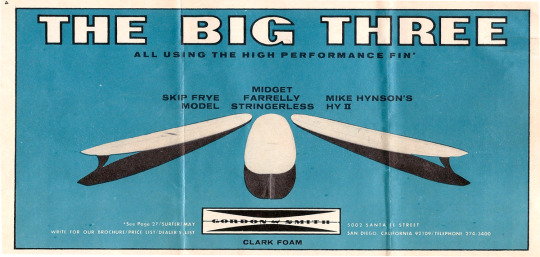
Photo via G&S
In conclusion, I don’t believe the board at the top of this post is a G&S Farrelly Stringerless model. Instead, I think it’s a slightly later G&S Farrelly V Bottom. See the ad below, taken from G&S’ website. If you look closely you can see the second board from the left is called the “Midget Farrelly V Bottom” model. I believe this is the same model as the board at the top of the post. And while the Farrelly V Bottom does not have a stringer, it should not be confused with the Farrelly Stringerless model, which is a longer board.

Photo via G&S
I’ve found pictures of the Farrelly V Bottom model elsewhere online, and here are a few examples. In this one below you’ll note that it has a tunnel fin, which I believe was added afterwards.

Photo via Gbase
This board below -- which I found floating around on Pinterest -- looks like an exact match to the one at the top of the page. It has similar deck patches, logo placement, and of course the overall outline. The picture below also gives a better idea of the vee in the tail, which is of course one of the defining characteristics of the board.

The board for sale can be found here on Craigslist. The seller also looks to be getting rid of some other gems, including a Morey Pope Tracker and a mystery David Nuuhiwa model. None of the boards are cheap, but they look well cared for. I’m wondering if these weren’t all at some point part of a larger collection that was sold off a few years ago, also in the Monterey area.
Finally, while we are on the topic of Australian surfing luminaries, I cannot recommend surfresearch.com.au enough. This article on 1967 and the creation of the vee bottom is incredibly thorough and detailed, and a real treat for anyone who’s interested in the topic. The same can be said for surfresearch.com.au’s entry for Farrelly himself, which is a fitting tribute for a true legend of the sport.
#vee bottom#vintage surfboards#midget farrelly#gordon and smith#g&s surfboards#G&S#gordon and smith surfboards
1 note
·
View note
Text
Shred Sledz Presents: Mid-Week Grab Bag
Greetings, Shredderz! As always, here’s a little selection of some cool boards you can find for sale online.
Bing Bonzer on Craigslist (San Diego)

This thing is 8′4″ and it’s got all the cool branding you would expect from this unique Campbell Bros / Bing collaboration. However, there’s some discoloration going on. Check out the Bonzer-branded glass on fins, though!
Greg Noll Mini Gun on Craigslist (Sarasota, Florida)

This thing is pretty trashed, honestly. I don’t think it’s worth buying. Nonetheless, it includes a good close up picture of the Mini Gun logo. More than anything else this is a great opportunity to share some cool older surfboard logos. Click through only if you won’t be triggered by the sight of a collectible surfboard that has been abused throughout its lifetime.
Greg Noll 1950s Longboard on Craigslist (San Diego)

This board is no spring chicken either. Same deal with the other Greg Noll board listed above -- just look at the cool logo. This is a rare variant that has Noll holding a camera while riding (you can see that it actually rads “Surf boards and film productions.”) One interesting tidbit is that Stoked-n-Board has the filming logo corresponding to the late 50s, but the actual green logo as being in the 1960s.
Daytona Formula V on Craigslist (West Palm Beach, Florida)

This is a really cool looking vee bottom board. I don’t think Daytona was a particularly notable Florida label, but I’ve never seen one of these before. It’s in decent condition, maybe a little pricey at $300, but I love these cool vee bottom transitional boards.
Skip Frye Gordon & Smith Longboard on Craigslist (San Diego)

If you’re wondering why the link is missing...this thing was taken down very quickly! Someone jumped on this bad boy. It was going for $500. I couldn’t get a good idea of the condition but I tend to think these boards are quite collectible.
#bing bonzer#bing copeland#Campbell brothers#bing surfboards#vintage surfboards#Greg Noll#greg noll surfboards#gordon and smith#skip frye
0 notes
Photo

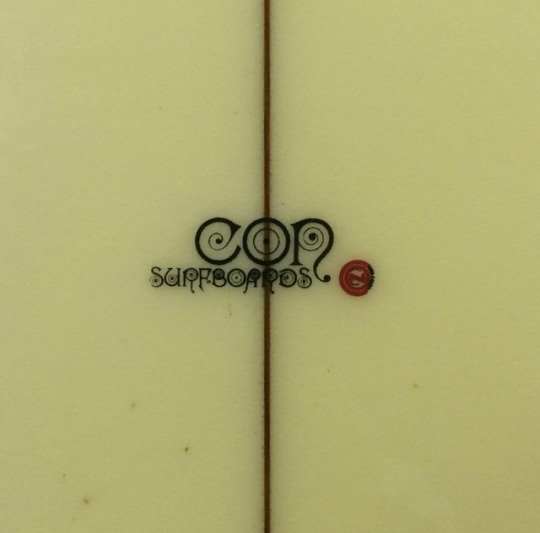





I’ve written before about my love for Con Surfboards. I’ve had some time to think about it...and I stand by everything I’ve said. I don’t know what it is but I just can’t get enough of vintage Con boards. That logo is just so killer! There’s something about the simplicity of the design that encapsulates everything I associate with the early days of California surf culture.

Photo via Ron Regalado
Enough with the pretentious prose, though: let’s get to the good stuff! In the pictures above you can see a groovy Con single fin that’s currently listed for sale on eBay. The board appears to be a variant on a traditional sting design.
There are a lot of interesting things about this board, but man, check out that insane arc tail! (Honestly, I didn’t even know what to call it, until I found this helpful breakdown of different surfboard tail designs by Rusty Preisendorfer.)
The wings on the Con board are not very pronounced, and they look to be pushed quite far back compared to other sting silhouettes. For example, take a look at this Aipa sting (Aipa, of course, invented the sting). The wings on the Aipa below are wider and located further up, closer to the wide point of the board:

Photo via Surfboardline.com
The Con board also sports a step bottom, which you can find on a decent number of stings. Here’s an example of a G&S sting (although I believe this is a board made in Australia, and not G&S’ native California), via the Cronulla Surf Museum, that features a clearly visible step bottom:
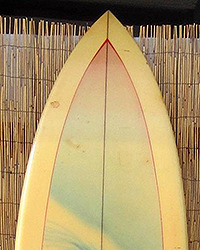
Picture via Cronulla Surf Museum
With that said, I can’t find any evidence of Con ever having made a sting. I’m not sure whether this was a specific model of board, or, more likely, a one-off. As for the date, Stoked-n-Board has a great entry on Con Surfboards, which has some good clues for when the board might have been made.
First, the board featured in the post has a clearly identifiable logo. It is the combination of Con’s script logo from the 70s, along with its classic red circle design. According to Stoked-n-Board, this logo was only produced between 1969 and 1974.
Those dates line up well with the other details for the board. First, you have a gorgeous rainbow fin in a fin box (not sure what kind of fin system), which points towards very late 60s and the 70s. Second, the sting was a design that came to prominence in the 70s, mostly thanks to Ben Aipa and the top Hawaiian pros of the time. According to the Encyclopedia of Surfing, the sting was invented in 1974. (See here for an earlier post on Aipa stings).
More than anything, I’m stunned that the board appears to be in such great condition. It’s almost to the point where I began to wonder if it was a retro board shaped more recently. However, I have my doubts that a retro board would have a rainbow fin, not to mention the funky details (the step bottom and the wings). My guess? The board at the top of the page is just in fantastic condition.
The board is going for $750. As far as I know, there’s no special historical significance to this thing. $750 is never cheap, but if I’m correct in saying the board is all original and in such fantastic condition, I’d argue that’s actually a reasonable price.
You can check out the board here.
0 notes
Photo




Happy Monday, Shredderz!
As you can see in the pictures above, I can’t say with a straight face that today’s post features a board in absolute mint condition. Since Shred Sledz prides itself on fostering a family atmosphere, let’s just say this board has been well-loved throughout its lifetime.
What today’s post does bring, however, is a deeper look at one of the most enduring designs in surfboard history.
The fish, as it is known, is one of the more popular variants on a standard shortboard. In a Surfline feature, Nick Carroll described the original fish as “a broad, super-wide-swallowtail with a straight rocker line and long-base rigid twin-fins.” Fish, thanks to their increased volume and better paddling ability, are go to boards for many surfers facing less-than ideal conditions.
Despite having been invented in the late 60s, the fish saw a resurgence in popularity in the 90s. A big part of this was thanks to Tom Curren’s surfing on a 5′7″ fireball fish in pumping Indonesian right handers, which was more or less uncharted terrain for a board seen by many as being suitable for waist high slop.
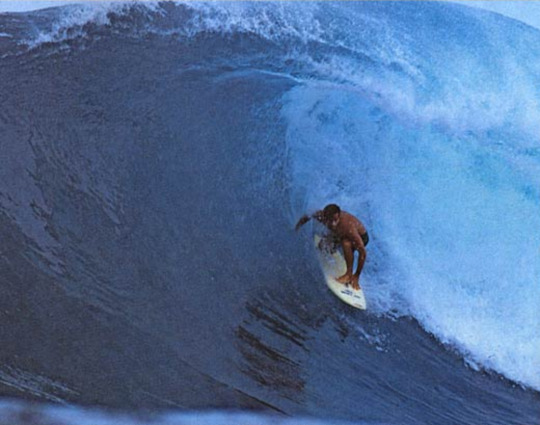
Photo by Ted Grambeau; via Surfline
...Lost Enterprises also released 5′5″ x 19 1/4″, an entire video dedicated to its stable of young team riders ripping on unorthodox equipment. What Youth recently ran an excellent retrospective on the video, which I recommend checking out.
So, before we get too deep down the fish rabbit hole...who invented the thing, anyway?
The man widely credited with inventing the fish design is San Diego kneeboarder Steve Lis, who created the distinctive swallow tail shape back in the late 1960s. Lis was doing some truly incredible surfing on these shapes in his San Diego stomping grounds, which helped create the initial groundswell of interest in his design. As always, the Encyclopedia of Surfing entry on Lis tells his story better than I could ever hope to.
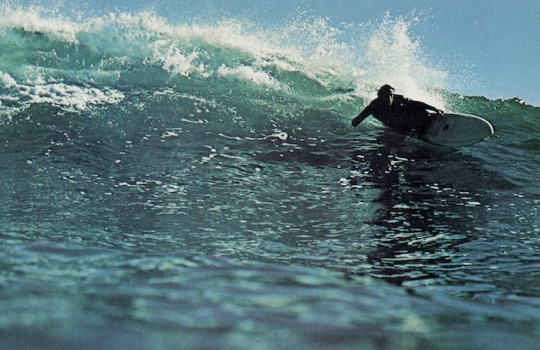
Steve Lis; photo by Warren Bolster; photo via Encyclopedia of Surfing
This brings us to the board pictured at the top of the post. There is a fish for sale on Craigslist in Orange County with Steve Lis’ name on it, but a few other details that I haven’t quite been able to sort out. And before we get into the history, just check out that awesome 70s airbrush!
As you can see in the first picture, the board is clearly branded with Lis’ name. However, the logo on the board is that of Choice Surfboards.
Choice Surfboards is one of the many brands from well-regarded San Diego shaper Rich Pavel (who also shapes under his eponymous label, Greenroom Surfboards, Axis / Access Surfboards, and even Rainbow Surfboards.) Pavel was a protege of Lis’, and he has continued to pump out fish designs on his own. Here’s a recent Pavel fish produced under the Choice label, and featured on San Diego shop Surfy Surfy’s own site. Notice the bigger Choice logo.


Photo via Surfy Surfy
The board listed at the top of the page appears to be a Lis / Choice collaboration, which I have never seen before. Stoked-n-Board’s entry for Choice lists Lis as having shaped for the brand from 1975 to 2009. However, the vast majority of Lis fishes I have seen have had his own branding, with no mention of Choice.
For example, here’s a Steve Lis handshape that was recently posted for sale on Surfer Magazine’s forum.

You’ll immediately notice a few big differences between the Lis posted to Surfer Magazine and then the Choice / Lis board at the top of the page. The first aspect is a clear Steve Lis logo:

Secondly, Lis hand-signs many of his shapes with a mirrored yin yang design (versus his own name). Here is his signature on the Surfer Magazine board:

Photos via Surfer Magazine Forums
Here’s another example of a Steve Lis handshape. A 1972 5′4″ Lis fish was recently sold via the Surfing Heritage Vintage Surf Auction, and ended up going for a tidy $3,500. You’ll notice there’s no logo anywhere to be found on the 1972 board.

Here’s a picture of Lis’ yin yang signature from that 1972 board.

Photos via California Vintage Surf Auction
What’s interesting about the Choice / Lis board featured at the top of the page is that it does not have a clear Lis signature. My guess -- and this is by no means definitive -- is that Lis supplied the template, which was then shaped by someone else.
With that said, the Choice / Lis board certainly looks vintage. The awesome airbrush screams 1970s, as do the dimensions of the board itself. According to the Craigslist post, the board is only 5′. Lis’ boards seem to have gotten longer as he has tweaked the shapes over the past few years. For example, the grey board taken from the Surfer Magazine forum is 6′2″ x 21″. There’s no leash plug, and the fins are glassed on as well.
It’s a shame the Choice / Lis board wasn’t better cared for, but oh well. I’m not sure what to say about how collectible it might be. I doubt it’s a Lis handshape, but then again, I have never seen one of these Choice / Lis boards before, and apparently neither have the far more knowledgeable folks at Stoked-n-Board. The board is priced at $200, which isn’t cheap for something this weathered, but this might be a good pickup for someone looking for an unusual example of a Lis-related shape.
Check out the Craigslist posting here.
0 notes
Text
Shred Sledz Presents: Thursday Grab Bag
Greetings, Shredderz! As always, here’s a collection of some rad boards that have popped up on the radar lately. Today’s post has a heavy 80s flavor to it, so if you’ve got a thing for neon, stick around and start scrolling.
Stussy Shortboard on Craigslist (San Diego)

If you don’t have a soft spot for 80s Stussy surfboards, then this is NOT the blog for you. This one has a bunch of sun damage, and the $1K price is steep, for sure, but these boards simply aren’t that easy to come by. This one has some rad artwork, and a very clear hand signature you can see in the picture above. I’d be very curious to see what this board ends up going for.
Schroff Blaster on eBay (Texas)

The 80s parade continues! This board is in excellent condition. Part of the reason why it has held its color so well is that it was apparently sprayed white. The poster claims this is one of the first 700 boards Peter Schroff shaped. I’m curious about that, given that Schroff used a standard script logo before the black and white grid logo seen above. In any case, it’s a beautiful board, and while bidding is low (<$70 now), I think you’ll see this one climb by the time the auction ends in four days.
Channel Islands / Al Merrick Tri-Plane Hull Quad Fin on Craigslist (Houston)

This one is SO close to being an exemplary collectors board. First of all, you can see that it is an Al Merrick handshape -- check the clear “Al / Fish” combo signature on the listing. It also has such great logos and branding, like the “Channel Islands” script running down both rails, and then a nice “Quad Design” logo on the bottom. But you can also see where repairs were made to the board, and the nose looks blunted as a result. It’s not necessarily a terrible deal at $200, either, but man, this could have been added to the Shred Sledz Signature Collection with just a few tweaks.
Takayama Funshape Thruster on Craigslist (San Diego)


This is kind of a funky Takayama board. I’m not sure what model it is, exactly, which is part of the mystery. And check out the logo on the bottom, which is not one you see every day. If you click through to the listing you can see that it has DT’s signature in pencil on the blank itself, meaning it’s not one of the newer boards where his signature has just been stamped on. Board is listed at $890.
#Stussy#shawn stussy#Peter Schroff#schroff surfboards#Al Merrick#Channel Islands#Channel Islands Surfboards#Donald Takayama#donald takayama surfboards#vintage surfboards
0 notes
Photo



Right now there’s a Yater twin fin for sale on Craigslist in LA for a reasonable $375 (pending, of course, a closer examination of the board for any soft spots, delam, etc.)
The board looks like it’s in pretty good condition. It has also had some work done. You can see the repairs on the bottom (see the second picture above).
What’s curious to me, though, is that I’ve never seen an example of a twin fin design from Yater. With the swallow tail it almost looks to be a standard fish design. If I had to guess, I would say this may have been made sometime in the 1980s, but I can’t be certain. There’s no mention of a twin fin on the history section of Yater’s website, either. I’d love to learn more if anyone has any info!
0 notes
Text
Shred Sledz Presents: Monday Grab Bag
Happy Monday, Shredderz! Here are a few boards that have caught my eye over the past few days.
Simon Anderson / Nectar Thruster on Craigslist (Los Angeles)


I’d love to do a more in-depth post on Simon Anderson. I’m just waiting to find one of his early thrusters go on sale so I can do the board justice with an accompanying post. (I featured one of his early single fin boards in this post.)
In the early days of Anderson’s pioneering thruster design, he licensed it out to Nectar so he could sell the board in America. The board linked above is a fantastic early example, apparently from 1981, and it looks to be in pretty impeccable condition. It’s not cheap at $569 but it’s not easy to find 35 year old boards in such great condition. If you’d like to read more about the Anderson / Nectar collaboration, I recommend this article at Boardcollector.com.
1960s Chuck Dent Transitional Board on Craigslist (Santa Cruz)

This Chuck Dent board is sporting some artwork that can only be described as groovy, and it looks like it is in pristine condition. Bonus: the board is seen pictured with an ultra-rare Gordon & Smith / Skip Frye vee bottom, with another logo I haven’t seen before. Not sure if the Frye is for sale (likely not), but it’s worth the click through, trust me. This bad boy is listed at $600. I’m not sure how collectible Dent’s boards are, but if the condition is every bit as ideal as the post suggests, then this could be a fair price.
1960s Rick Surfboards Lightweight on Craigslist (Los Angeles)

Neither of these boards are in particularly great condition, but if there’s one thing I love, it’s finding rare logos from old boards. It’s always a good sign when you can’t find the logo on Stoked-n-Board or Stanley’s Surfboard Logos, and I can’t find mention of a Rick Surfboards Lightweight model anywhere. Maybe this is a nod to Bing’s famous Lightweight model, given that Rick Stoner and Bing Copeland were once business partners? I can’t say for sure. At $700 I can’t really justify this cost, but oh well.
#simon anderson surfboards#Simon Anderson#nectar surfboards#rick surfboards#Rick Stoner#chuck dent#transitional surfboards#vintage surfboards
0 notes
Text
Friday Round Up
Hope this weekend is bringing the global Shredderz community some tasty waves. In the meantime, we’re experimenting with a new format. Instead of going super deep on specific boards and shapers, we’ll be presenting a grab bag of cool boards you can currently find for sale online.
Takayama 7′0″ egg on Craigslist (San Diego)
Not cheap at $1200, but it’s in great condition and has a cool acid paint job on the deck. It’s hard to see the signature but it looks right to me. Looks like a 90s Donald hand shape, and it has some cool egg logos to boot.

Stussy Shortboard on eBay
Don’t be fooled by the initial picture -- this thing is trashed, and it’s in pretty sorry condition. But hey, it’s always a delight to come across these boards. It’s currently <$200, so it could even be a rescue project for the right person. The only downside of looking at boards like this one is getting worked up over the fact no one took better care of it...but I digress.

Greg Noll board on Craigslist (Florida)
This one is priced fairly, which is to say, out of the price range for what Shred Sledz pays its overworked and underappreciated employees. Then again, they don’t come up for sale very often, so check it out before it moves into some weirdo collector’s giant air-sealed garage.

W.A.V.E. hollow board on Craigslist (New York)
I’ve written about these boards before, and they are a real trip. W.A.V.E. boards were created by Tom Morey and Karl Pope back in the 70s, and they featured a hollow, chambered design. This one looks to be in great condition, and it also has a gorgeous example of a 70s rainbow fin, which you can see in the pic below. It’s not cheap at $500, but oh well.

#Donald Takayama#hawaiian pro designs#Greg Noll#Stussy#shawn stussy#vintage surfboards#w.a.v.e. surfboards
0 notes
Photo


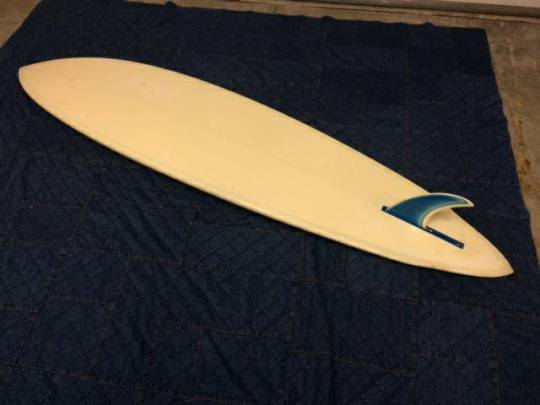




Good morning, Shredderz! Today’s post will cover the one and only Reynolds “Rennie” Yater, a Santa Barbara fixture and one of the better known shapers in all of California history.
If you’re a film buff with a great eye for detail, first of all I’d like to say I have no idea how you ended up here, but I’m glad you haven’t left yet. Secondly, I’d add that you might recognize Yater from his cameo in Francis Ford Coppola’s “Apocalypse Now.” Lieutenant Colonel Kilgore, the surf-obsessed madman played by Robert Duvall, wields a Yater board in the movie’s iconic surfing scene. The board sports a pretty bitchin’ custom paint job, too:

When Kilgore isn’t shouting “Charlie don’t surf” and clearing lineups in the Mekong Delta, he can be seen sporting a Yater t-shirt:

Reynolds Yater, for the uninitiated, is a legendary California surfboard shaper who got his start in the 1950s. Yater might be in his eighties now, but he continues to shape boards under the Yater Surfboards brand today. If you haven’t already, you ought to read his Encyclopedia of Surfing entry, which contains this awesome pic of Yater at the Hollister Ranch:
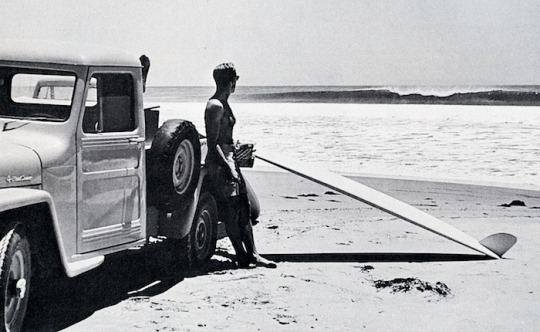
Photo via Encyclopedia of Surfing; photo by John Severson
Yater is best known for his longboard shapes. He invented the Yater Spoon in 1965, which was an incredibly modern noseriding shape for its time. Yater is probably best known for his longboards, but as you can see at the top of the post, you can currently find one of his shortboards for sale on Craigslist, in Petaluma. The board pictured at the top of this post was shaped sometime during the seventies. There are two pieces of evidence that point to this fact. First is the logo, which is a more stripped-down design than the classic “Santa Barbara Surf Shop” Yater logo, which I’ve reproduced below. Stoked-n-Board’s comprehensive entry for Yater Surfboards matches the logo in the first pic to boards shaped in the 1970s.
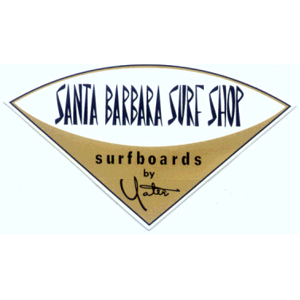
Photo via Stanley’s Surfboard Logos
The second giveaway is the rainbow fin, which looks to be in excellent condition. The same can be said for the entire board, which looks pretty great considering it was originally shaped almost 50 years ago. I can’t spot any obvious telltale signs of the board having been restored, but take that with a grain of salt.
Yater’s best known shortboard shape is the Pocket Rocket model, which was designed during the transitional era of the late sixties and early seventies. According to the Yater Surfboards website, “From 1969-72, [Yater] produced the Pocket Rocket, a surfboard designed with Hawaiian surfing in mind, riding the crest of the short board era.” I’m not sure whether or not the board at the top of this post would be considered a proper Pocket Rocket, but my early guess is no. Here are some pics of a recent Pocket Rocket reproduction (shaped by Yater), and you can see the outline is far more pulled in and narrow. In addition, it’s missing the wings you can find in the tail of the board at the top of this post.


In addition, here’s an example of a 1969 Pocket Rocket that recently went up for auction. You’ll see in the second pic that the auction board has a glassed-on fin, versus the fin box in the board at the top of this post.


Photos via California Surf Auction
Finally, here’s a third example of a vintage Pocket Rocket, which was sold in 2001 at Randy Rarick’s Hawaiian Island Vintage Surf Auction. I can’t find any information on the closing price, but as you can see in the pictures below, the board has the same narrow outline as the other examples.


Photos via Hawaiian Island Vintage Surf Auction
Regarding the board at the top of this post, even if it’s not a traditional Pocket Rocket design, it’s still a fantastic example of an early Yater shortboard. It looks like it’s in fantastic condition, too. There is no price listed on Craigslist, but the seller says he is accepting offers. You can find the board for sale here.
As a bonus, the good folks at Pilgrim Surf + Supply published a great interview with Yater where he reminisces on his career and his influences. Check it out here if you’re interested.
1 note
·
View note
Photo



Happy Monday to all you faithful Shredderz out there! I hope this week brings you a non-stop procession of tasty waves and interesting surf craft.
I figure there is no better way to start the week than with the holy matrimony of Lightning Bolt Surfboards and Hawaiian legend Gerry Lopez. If the name Gerry Lopez rings a bell, it’s because you may recognize him from his role as Schwarzenegger’s sidekick Subotai in “Conan the Barbarian.”

Actually, that’s nobody’s first impression of Mr. Lopez, but it is an irresistible piece of surfing trivia.
All jokes aside, surfing legends don’t get any larger than Gerry. For goodness sake, the dude’s nickname is Gerry “Mr. Pipeline” Lopez! And with impeccable style like this, it’s a miracle they haven’t re-named the spot after Gerry himself:



Top and middle photos via Jeff Divine; bottom photo via Encyclopedia of Surfing.
First, some background on the man and the marque. Lopez, along with business partner Jack Shipley, founded Lightning Bolt in 1970. (For more extensive background, see the Encyclopedia of Surfing’s entry on Lightning Bolt.) Lighting Bolt started with an unorthodox business model that was more akin to a collective than a real brand. According to the EoS, Bolt initially did not have a centralized factory where all of the production took place, and instead a variety of shapers -- including Lopez himself, and other notables like Reno Abellira, Tom Parrish, Tom Eberly, and Barry Kanaiaupuni -- shaped at home and then brought their wares into the Bolt store for sale.
Lightning Bolt was ubiquitous during the 1970s, and even today it remains at the forefront of surfing’s consciousness. Unfortunately, Lightning Bolt’s history can also be read as a cautionary tale about the perils of poor brand management. Other brands and shapers shamelessly borrowed the distinctive logo, slapping it on boards that had nothing to do with Lightning Bolt.
Even “official” Lightning Bolt surfboards have a mixed history. Take, for example, the green and yellow board pictured at the top of this post. The board was originally posted for sale on Craigslist in Los Angeles, where it was advertised as a Gerry Lopez surfboard. And as you can see in the second picture, there’s a clear “Gerry Lopez” laminate bearing the man’s name himself. So far so good, right?
Unfortunately, the board at the top of this post was unlikely to have been shaped by Gerry himself.
According to Randy Rarick, boards that bear the “Gerry Lopez” laminate -- not to be confused with a signature -- are “California Bolts” that were licensed to a variety of different businessmen around the world, including a factory in the San Diego area. Two shapers that made these California bolts were Terry Martin and Mickey Munoz. There is some good context on California Bolts and the licensing of the Bolt name on Boardcollector.com.
So, what does a hand-shaped Lopez board look like, then?
Here’s an example of a 1970s Lopez board that was sold at the recent California Vintage Surf Auction. Note: this board has been restored. But it does contain a clear Lopez signature on the stringer, which at the very least is meant to refer to how these original Lopez boards would have looked:

Image via Surfer Magazine Forums
Surfboardline.com has an incredible selection of Lightning Bolt boards, where you can compare boards that have the Lopez laminate, versus ones where you can clearly see his signature beneath the glass. For an example of the latter, see the picture below:

Pic via Surfboardline.com
In summary, Lopez seemed to sign many of the boards he hand-shaped. And those that he did sign, he did under the glass, in all capital letters along the stringer. His other boards are fantastic and are collectible in their own right, but it’s worth exploring the distinction between a board shaped by Lopez, and one that he assisted in designing.
The board at the top of this post has already been taken down (asking price was $650, for those who care about price points). Even though it’s not a “Lopez” board in the strictest sense, it’s still a wonderful piece of surfing history, and a tribute to a real classic.
0 notes
Photo




Now, I realize that 2004 might not be everyone’s idea of vintage. And you know what? That’s totally fine, because I happen to be the guy in charge of this very blog (mostly because no one else wanted the job, but I digress).
Still though, when it comes to Kelly’s personal boards, especially those that were hand shaped by legendary shaper Al Merrick, the Shred Sledz editorial staff is more than willing to bend the rules a little bit.
Pictured here is a 7′2″ Al Merrick board that was ostensibly shaped for Kelly, which you can currently find for sale on Craigslist in Hawaii.
Everything seems to match up. First, the K logo clearly indicates the board above is a Kelly Slater model that was produced during much of his time with the Channel Islands brand. While the K Board was released to surf shops as a signature model, towards the end of Kelly’s stint with CI, he simply applied the logo to a variety of designs. Here’s a shot of Kelly’s quiver from the 2011 Hawaii season, via the Channel Islands blog, that shows the K logo on a wide range of boards:

Photo via Channel Islands Surfboards Blog
The other interesting thing about the board pictured in the first set of photos is the fact that it has a thruster setup. Nowadays, Kelly’s boards, like those of most pros, sport a five fin setup that allows toggling between a standard thruster fin configuration, and then a quad fin config for when the waves get bigger and more critical. Here’s a shot from 2014, towards the end of Kelly’s tenure with CI, that shows a five fin setup (though note the K logo is gone):

Photo via Channel Islands Surfboards Blog
The tri fin setup indicates that the board in the first set of pictures is an older one. There’s a date on the stringer that says 2004, which sounds about right, given that the five fin configuration didn’t become popular until a few years afterwards.
Speaking of the signature, you can see Al’s trademark Al / fish signature, as well as the name Kelly written into it. This makes me all but certain this is a board Al shaped himself for Kelly. See below for an example of another Al / fish signature. It follows the same format as the pic in the set at the top of the page.

Example of another Al Merrick signature
Finally, the interesting thing is that this board, given its location and its size, was probably crafted as a step up for Kelly’s winter months in Hawaii. It seems practically outdated now, given that Kelly routinely surfs sub 6′ boards at macking Pipeline. Here’s a picture of Kelly about to paddle out at the 2016 Pipe Masters with one of his new Slater Designs boards. You can see Kelly’s 2016 board is well short of 7′2″. One of the biggest innovations in surf craft in recent years has been the downsizing of equipment in serious conditions. Leading the charge, of course, is none other than the shiny headed G.O.A.T.

Photo courtesy Firewire Surfboards Blog
For some more eye candy, here are three shots of Kelly, taken over the span of almost 25 years (!!!), that show how his equipment at Pipeline has evolved over the years:



Top photo via Jeff Divine; Middle photo via Bielmann; Bottom photo via Red Bull
Nowadays, of course, Kelly is working on Slater Designs, his own line of boards produced in conjunction with the good folks at Firewire Surfboards. Slater Designs offers some cutting edge, high performance shapes that were created via collaboration with high profile shapers like Daniel Thomson and Greg Webber.

Photo by Sherman, via Surfing Magazine (RIP)
For many of us, however, Kelly and Channel Islands / Al Merrick will forever be an enduring combination. And the board that’s being offered for sale, at a steep $2,000 dollars, might just be a collector’s item one day. I don’t have a crystal ball, but I can’t imagine there are that many genuine Merrick boards shaped for Kelly that will be up for grabs. Kelly is the greatest surfer ever -- and the most influential -- and one could make that same argument about Al Merrick and shaping as well. So it’s interesting to wonder if boards that represent this pairing will only become more valuable and meaningful over time.
You can find the board here.
#kelly slater#al merrick#Channel Islands#Channel Islands Surfboards#firewire surfboards#slater designs
2 notes
·
View notes
Photo




There are days when the search for rad surfboards can seem like an endless slog. There are others, though, when gems seem to fall out of the sky right into my lap.
Consider this board the latter. Up for sale on Craigslist in Honolulu is a Harbour Banana model that looks like it was likely shaped sometime in the 1970s.
What’s immediately interesting to me is the alternate Banana Model logo, which I have never seen before. Stoked-n-Board’s entry for Harbour lists no such logo, and it’s always exciting to find something that the eagle eyed editors at S-n-B haven’t encountered. I found a similar one on Stanley’s Surf Logos, which I have reproduced below. Unfortunately, there are no shots of the corresponding board, but you can see this is an excellent example of the alternate Banana Model logo.

Photo courtesy Stanley’s Surf Logos
Contrast this to the “classic” Harbour Banana Model logo, taken from a pic on Harbour’s website:
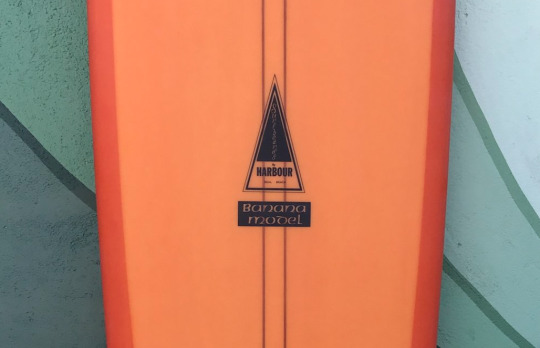
Photo Courtesy Harbour Surfboards
The second interesting thing about the board pictured at the top of this post is the fact it is more of a transitional shape, whereas the Banana Model is a traditional noserider. Currently, you can only order the Banana Model from Harbour as a longboard, and the only vintage examples I have seen are all 9′ plus. The Craigslist board at the top of this post, by contrast, is 7′10″. It looks to have way more in common with the Harbour Spherical Revolver, which was a transitional board offered up by the brand starting in 1969. The picture below was taken from DIS•PLACE•MEN•TIA, an excellent displacement hull-centric surfboard blog.

Photo courtesy DIS•PLACE•MEN•TIA
Finally, there’s a clear serial number of #64 beneath the alternative Banana logo, which you can see in the fourth pic at the top of the post. It’s unclear if this is meaningful, but it’s worth noting nonetheless.
I’ve reached out to the fine folks at Harbour Surfboards to try and get some more information. If I find out more I will update the post.
In the meantime, check out the board for sale here. It’s $400, and given the condition and the relative rarity of the board, I would be VERY tempted if I were in the Honolulu area.
0 notes
Photo

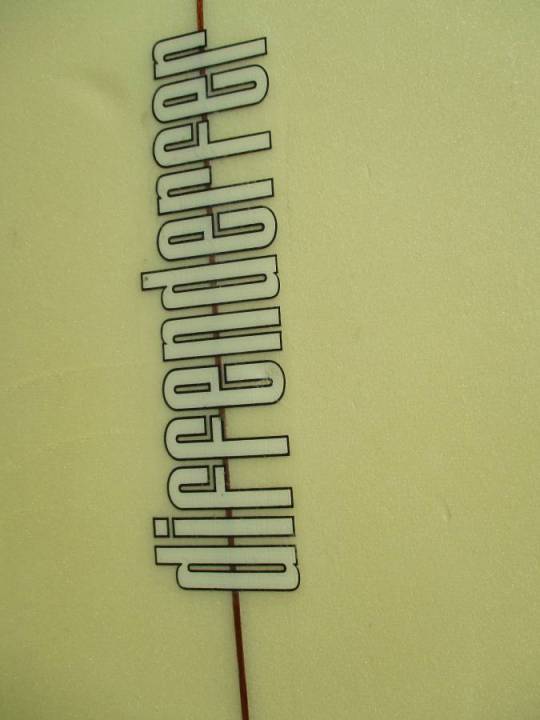
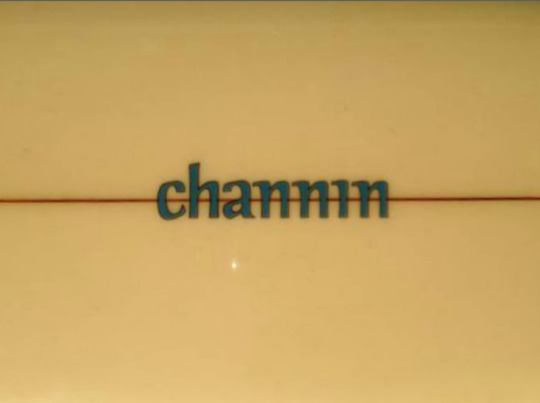
Here at Shred Sledz we love old surfboards of all shapes, sizes, and creeds, but if there’s one thing that makes us go particularly crazy, it’s surfboard brands that are no longer with us.
Today’s post is a brief history on the Channin / Diffenderfer partnership, which eventually spawned a few different brands. And of course, we have pictures of some neat boards, for those of you who never bothered with the pretense of reading Playboy for the articles.
According to this wonderful article, Tony Channin and Mike Diffenderfer first went into business together in 1965. Channin had made a name for himself as an outstanding glasser in the San Diego area, while Diffenderfer had been honing his surfing and shaping skills in Hawaii. Their brainchild, Channin Diffenderfer, produced surfboards until 1970, when both men went their own ways, setting up brands under their own names.
Today’s first board is a Channin Diffenderfer. The picture below (as well as the first picture in the set above) was taken from a Craigslist post in San Diego that has since been taken down. Diffenderfer was the main shaper, but according to Stoked-n-Board, there were other shapers who made boards under the Channin Diffenderfer label as well. There’s no signature on this board, which makes it difficult to say whether this board was shaped by Diffenderfer himself.

Picture from Craigslist
The second board today is from the Channin brand, after Tony and Mike went their respective ways. It’s a 7′0 pintail single fin that you can currently find on Craigslist in the San Diego area, where Channin is located. The board is listed for $850, which I find totally unrealistic. Price aside, it’s a clear example of a Channin branded board. Channin employed a number of different shapers for his own label, and without a signature, it’s difficult to say who may have shaped it.

Picture courtesy Craigslist
Finally, to complete the trifecta, there is a Diffenderfer branded board that is up for sale on Craigslist right now. I have included pictures below. It’s an 8′11″ single fin, and if I had to guess, it’s a more recent board (1980s or 1990s, maybe?) Diffenderfer, sadly, passed away in 2002. What’s interesting about this board is that even though it is made under the Diffenderfer brand, it was still glassed by Channin. You can see the clear “Channin Precision Fiberglassing” logo at the tail of the board as well. According to Stoked-n-Board, a man named Jim Allen also shaped under the Diffenderfer label. I find it interesting that this board bears a laminate that reads “Custom Shape by Mike Diffenderfer”, but there’s no signature.


Pictures from Craigslist
Anyway, there you have it. I hoped you enjoyed this journey through the various iterations of the surfboard brands of Tony Channin and Mike Diffenderfer. Happy Shredding!
0 notes
Photo








Some would say that the late 1960s and the early 1970s were the awkward teenage years of surfboard design. During this time, known as the Transition Era, surfboard shapers were figuring out how to gracefully pivot from longboards made for noseriding, into the shorter, more high performance shapes that we take for granted today. I love the uninhibited embrace of experimentation during this time, which has resulted in some pretty funky and distinctive boards, many of which look slightly crazy today.
There are two Dewey Weber SKIs that are currently up for sale on eBay, which you can find here and here. I have reproduced those pictures here on Shred Sledz for your enjoyment, along with a little bit of history of the board.
SKI is apparently an acronym that stands for “synthetic kinetic instinct”, which is about as hilarious as marketing mumbo jumbo gets. According to Stoked-n-Board, the SKI was created in conjunction with Australian surfing great Nat Young (not to be confused with current Santa Cruz pro of the same name.) Weber’s own website tells a slightly different story: “[the SKI] was strongly influenced by Dewey & former Weber Team riders Nat Young, Mike Tabeling & Harold Iggy (sic).”
First and foremost: mamma mia, look at those mint condition logos! If that doesn’t bring a tear to your eye...well, then you are probably just a normal human being who lacks my utterly dysfunctional and crippling obsession with surfboards. But enough about me.
In the first logo, you can see text that reads “Australian inspired for Dewey Weber Surfboards.” This is a clear nod to Young, one of the most famous Aussie surfers ever. Young rode a version of this model in the seminal surf flick “Morning of the Earth.” This makes me think that Weber’s version of the story isn’t necessarily as generous to Young’s contributions as it might have been. (Not to mention the fact Mike Tabeling was from Cocoa Beach, Florida, and Harold “Iggy” Ige hailed from Hawaii).

Nat Young in “Morning of the Earth.” Photo courtesy of Albert Falzon.
It’s really fascinating to compare the two different logos. I’m not sure why they are so different, when S-n-B indicates that The SKI was only produced in one year, 1969. The second one reads “Combination of water displacement and planing hulls by Weber Surfboards.” This sounds a bit like what we would call a displacement hull today, a la Andreini and co, but I can’t be positive.
These two listings also have clear photos of the Waveset fin box, which was common in boards at this time. Here’s a photo of a Waveset fin outside of a box. You can see the ridges in the base of the fin, which correspond to the corrugated shape in the fin box.

Photo courtesy Swaylocks.com user Atomized
Both boards are currently going unbidden on eBay with starting bids under $200. Who knows where they’ll end up. Here is a link to the seller’s profile.
0 notes
Photo
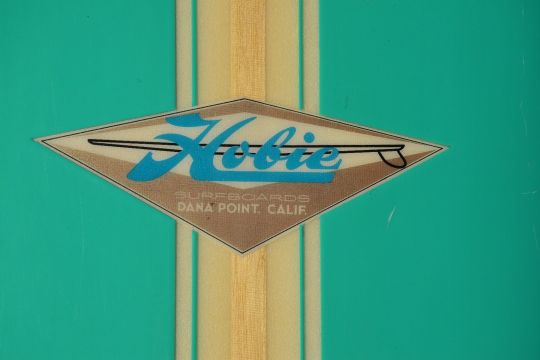




Bon weekend, fellow Shredderz! If, like me, you’re in rainy California, I’m here to deliver some sunshine in the form of what looks to be a vintage surfboard in pretty primo condition.
Pictured here is a Hobie longboard that is currently for sale on eBay. It’s not going to be cheap -- there’s a reserve on the auction and the buy it now figure is at $1,700 -- but it’s a beautiful board.
The poster claims this 9′6″ longboard was purchased in 1965 and kept in pristine conditions in the 50 years since then.
It’s hard to find detailed knowledge on vintage Hobie Surfboards online, mostly because Stoked-n-Board doesn’t have its usual wealth of information on the brand. While there’s a serial number visible here -- looks like 16837 (probably?) --one of the few tidbits S-n-B offers for Hobie is that the numbering is not reliable.
To me, it seems extremely likely that this board hails from the 60s. Stoked-n-Board has two other data points that are interesting. First, S-n-B claims that Hobie offered glass-on mahogany fins in 1964, which matches up well with the timeframe for this board. Second, S-n-B claims that Hobie offered 3/4″ spruce stringers in 1966. I can’t say whether or not the stringer is spruce, but it looks 3/4″, and again, this is in the ballpark of 1965.
The board is clearly a pig shape, defined by Surf A Pig as having “weight, belly, wide point aft, a skeg (D fin) and a narrow nose.” There aren’t enough pics to see the bottom of the board and a belly, but the other criteria have been met. The pig silhouette also matches up to the 1965 date mentioned in the post.
If you’re the paranoid type, the one concern is that the board is in almost TOO good of a condition. It is exceedingly rare to see 50 year boards that have aged this well, with no damage or dings anywhere. I can’t say for sure either way, but if I were looking at buying this board, I would be interested in doing some research as to whether or not it had been restored or re-glassed in any way. If the board is indeed all original, this is a pretty stunning example of an original 1960s Hobie.
You can check out the board here.
0 notes